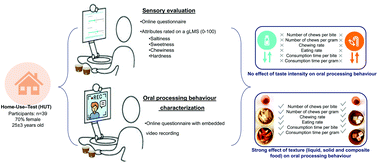Oral processing behaviours of liquid, solid and composite foods are primarily driven by texture, mechanical and lubrication properties rather than by taste intensity
Abstract
The aim of this study was to understand the influence of saltiness and sweetness intensity on oral processing behaviours of liquid, solid and composite foods. As salty foods, tomato sauce (liquid), penne pasta (solid) and their combination (composite food) were used at two levels of saltiness intensity (low/high). As sweet foods, strawberry sauce (liquid), milk gels (solid) and their combination (composite foods) were used at two levels of sweetness intensity (low/high). Saltiness, sweetness, hardness, chewiness, and liking were quantified using generalized labelled magnitude scales (gLMS). Oral processing behaviours were determined using video recordings (n = 39, mean age 25 ± 3 years) in a home-use-test (HUT) providing fixed bite sizes for all foods. As expected, taste intensity differed significantly between samples within the same food category. No significant effects of taste intensity on oral processing behaviours were found for sweet and salty foods. As expected, consistency strongly affected the consumption time per bite, number of chews per bite, number of chews per gram and eating rate. Solid foods were masticated for the longest time with the highest number of chews per bite, followed by composite foods as the liquid added to the solid foods enhanced lubrication. Liquid foods were masticated for the shortest time. We conclude that large differences in saltiness and sweetness intensity of liquid, solid and composite foods cause no differences in oral processing behaviours. We suggest that oral processing behaviours are primarily driven by texture, mechanical and lubrication properties of foods rather than by their taste intensity.

- This article is part of the themed collection: Food structure, sensory perception, and nutrition


 Please wait while we load your content...
Please wait while we load your content...